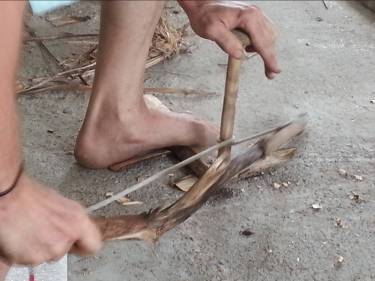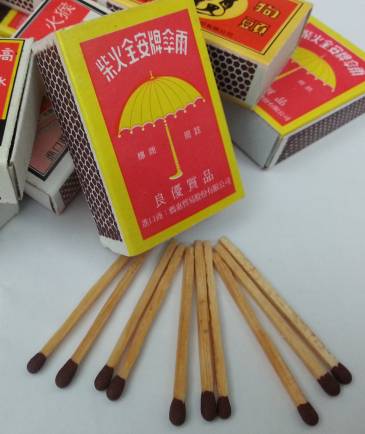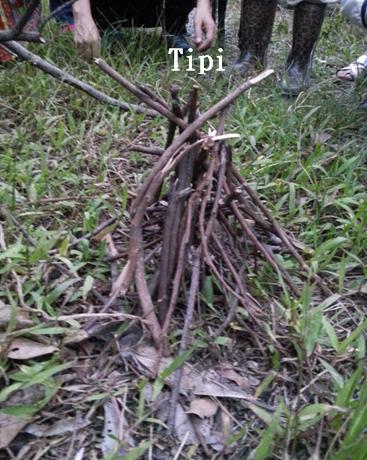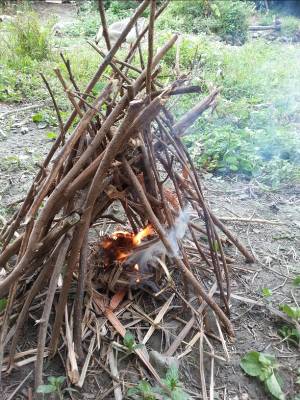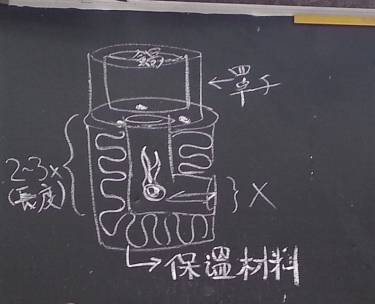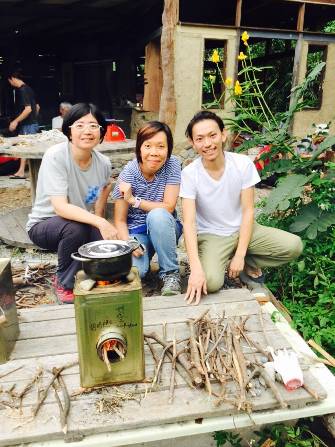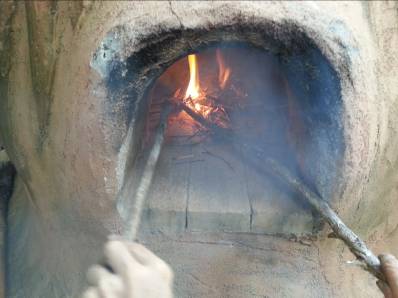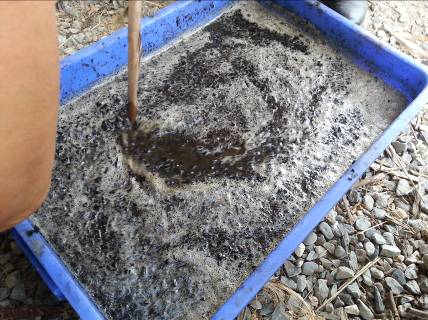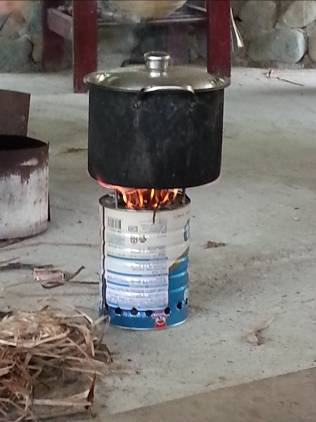3-day Permaculture Workshop – Fire
撰文|胡明趣 (2015自力生活練習所-火工作坊學員,來自香港的夥伴目前移居台灣)
Feedback from Workshop Participant, Funny Wu
攝影|胡明趣 & 朱崇莉 Photo by Funny Wu & Julie Chu
(一)十根火柴對城市人的意義?
對很多城市人來說,火柴跟自己的生活好像沒有甚麼關係,在哪裡買到就更不知道,因為打火機基本上也取代了它。幸好我小時候有機會用過,所以並不陌生,也曾經在淡水的雜貨店買過。可是要用它來點火燃燒tipi,卻並不是我想像中那麼容易。Peter老師作示範看起來很容易,當我們兩個人一組嘗試起火,點了十根火柴﹝當刻僅有的資源﹞點燃tipi內的鳥巢火種,最終還是失敗。也許從技術的層面來探討,失敗的原因可能很多,另外也可以為自己找藉口扯到外在的因素,天黑看不清楚之類的,但我想分享卻是別的發現,我這個城市人太心急和專注力不足應該是導致失敗的主要原因吧!謝謝十根火柴給我的功課和啟發,也感謝大自然給我的自省能力。
(1) How significance of 10 matches to city dweller?
For many city dwellers, the matches are nothing to deal with our daily lives. We do not even know where to buy because the lighter has basically replaced it for long. When I landed to Taiwan from Hong Kong, I managed to buy it at the old grocery store in Tamsui, Taipei. When I was a child, luckily I had the opportunity to use it. That is why I am not unfamiliar with it. But having said that it was not as easy as I thought when I used it for tipi ignition. When our workshop teacher, Peter demonstrated how to ignite tipi, it looked very easy. However when I tried in a group of two to set fire to tinder putting inside tipi using ten matches (the only resources allocated), we failed eventually. Perhaps from a technical perspective there could be a lot of reasons causing to failure. I could even make excuses to external factors, like under the dark not being seen clearly, but I just want to share reflections about my impatience and lack of mindfulness as a city dweller that would likely be the major cause of failure! Thanks ten matches for my homework and inspiration, and also thanks nature for giving me ability to introspect.
(二)漆黑中與大自然擁抱感受到心靈的聲音嗎?
四野無人漆黑一片,同學們在空地上圍了一個圈,安靜聆聽自己內心的聲音,卻發現有意外的驚喜。雖然身邊有人,但卻因為天太黑專注力都可以放在自己和大自然的懷裡。城市人本來就很難安靜自己,往往有雜聲讓人不能安靜,或怕太安靜不敢面對自己。當我可以安靜下來時,由衷的感謝創天造地我所信的上帝,這是一種久維了的感覺,過著匆忙的生活久而久之便覺得有一些事,是理所當然,卻忘了感恩。感謝樹林供應我所需的氧氣,除去我不需要的二氧化碳,大樹幫我遮風擋雨,在妳的懷裡我感到滿足。
(2) Embracing the nature in the dark, can I hear the inner voice of my soul?
In utter darkness and silence, the workshop participants we in a circle surrounded in an open space of the plantation, I attempted to quiet myself to listen to the inner voice of my soul. Unexpectedly it surprised me. Although there were people around me, I could put the focus on myself and into nature in utter darkness. In the city, it would be very difficult to quiet myself due to all the unwanted sound arising from various noise sources. Or I fear that silence will lead me to face my true self. When calming down, I showed my sincere thanksgiving to my heavenly Father who created the heaven and the earth. This seemed to be a long-lost feeling. Living in rush city over time, I tend to take things for granted and forgot something very important about thanksgiving. I thank the woods to supply oxygen I needed, and remove carbon dioxide that I do not need. I also thank trees to give me shelter from the rain and the wind. I feel content being in the nature.
(三)回到原始鑽木取火最大的挑戰?
十根火柴點燃tipi都不成功,還要鑽木取火簡直是不可能完成的任務。一整套工具包括弓﹝Bow﹞、鳥巢火種﹝Tinder﹞、爐板﹝Hearth Board﹞、鑽頭﹝Drill﹞等都是用在地的資源來自製,好像回到最原始的生活方式,花了大半天流了不少汗水才自製完所需的工具,鑽木取火才正式開始。今次三個人一組,不同的組合也許有不同的化學作用。大家試用不同適合自己的姿態鑽木取火,來跟那些工具打交道,希望可以好好的掌控它,但花了不少體力卻沒有果效,信心備受打擊,正好是考驗團隊的決心是否繼續堅持下去。剎那間看見隔壁的小組開始築鳥巢火種及tipi,激發我不能輕易放棄的想法,憑信心我組也開始築我們的鳥巢火種及tipi,萬一真的鑽木取火成功,便需要有東西被點燃。以前聽別人說『不是看到希望才去堅持,而是堅持了才會有希望』,今天我親自體會了,所以最後我們成功了!
(3) What is the biggest challenge using the primitive fire bow drill?
Tried in vain to ignite tipi by using ten matches, taking another challenge to use the primitive fire bow drill it seemed mission impossible. A complete set of tools to be hand made using local materials includes bow, tinder, hearth board, drill, etc. Like going back to the most primitive way of life, we in a group of three spent a lot of time with sweating to hand make the tools needed before actually to start a fire. Different combinations of team members would have different chemical reaction. We tried different posture adjusting to our own comfort to handle those tools with an intent to properly work under control. However, having spent a lot of our physical strength, it was unfruitful. The team’s confidence has been badly shaken. This seemed to be a test to the team’s determination to keep on trying or not. Suddenly I saw the neighbor team began to build tipi which triggered me to carry on not to give up so easily. By faith I began to set up my team’s tipi, in the hope that just in case we successfully started a fire by bow drill, there would be something to be ignited. Before I have heard people saying that, “not seeing hope so we uphold but to insist so we see hope”. Today I personally experienced it, so we finally succeeded!
(四) 廢棄物回收組裝火箭爐能不能用呢?
聽完Peter老師解說理論,我們便開始組裝火箭爐。鑽木取火的組員再次合作,大家已經有了相當的默契,有人去拿廢棄物,有人拿工具,有人找工作桌,然後便動手組裝火箭爐。組裝的過程也算順利,看起來也很像Peter老師示範用的哪個爐,可是我心裡真的有點懷疑它能不能用。不管啦,可是因為我組三個人都不打算拿它回家,而是送給別組的同學,讓她可以拿回學校當教材,我便有點擔心萬一它不能用甚麼辦?當測試成功,能送一件用廢棄物回收組裝成有用的東西給同學作教材,感到很大的滿足和覺得施比受更為有福,也很開心與簽了名字作記號的火箭爐,和我組同仁合照留念。
(4) Can a functional rocket stove be made from recyclable cans?
After the explanation of the theory by Peter, we began assembling the rocket stove using recyclable cans. The same team members to work together again, we have a considerable understanding to each other. Someone collected recyclable cans, someone took the required tools, and someone looked for work tables, we then started assembling our rocket stove. The entire process of assembling went smooth, the final product looked like the one Peter demonstrated to us, but I was wondering whether it would be functional. Don’t care as long as the work is done. However, I came back wondering its functionality when my team determined to present it to one member of the neighbor team who was planning to bring it back to her school for student teaching material since no one in my team would take it back home. When we passed the functional test, I felt content with making waste useful to the students as a teaching material, and blessed to give than to receive. I was also very happy to take a photo with the rocket stove having our names signed together with my team members.
(五)第一次用麵包窯烤pizza有風味、好味道嗎?
由於我手有點髒,還有手指有點傷痕,所以便不方便參與預備pizza的食材,特別是用手揉麵粉。我也有自知之明,煮東西並不是我的強項,便讓在這方面有天份的同學們來發揮他們的廚藝吧!我負責運送pizza到麵包窯,還有很重要負責吃,分享同學們第一次做pizza的喜悅,很有風味也很好味道,因為是大家用心的作品。最特別的pizza應該是鹹蛋加薑,很不錯耶!不單是食材預備用心,還有是負責麵包窯操作的老師和同學們的辛勞,很神奇不用溫度計可以知道窯裡面的溫度,大概甚麼時候適合烤pizza,烤多久等。沒有老師過去累積的經驗,我們又哪來可以享受有風味和好味道的pizza,感謝老師!
(5) First attempt using bread kiln to bake pizza, is flavor great or/and taste good?
Since my hands were dirty and had finger bandage, so I therefore did not involve in ingredients preparation, particularly flour rubbing exercise. I have self-awareness in recognizing cooking is not my strength. Let those talented group members to develop their cooking skills! I was responsible for the delivery of pizza back and forth to the bread kiln, as well as tasting the baked pizza which was an important task. I shared the joy and happiness with those people of first attempt to do pizza particularly, it was great flavor and good taste because it was made with all their heart. To me, the most special pizza would be the one with eggs and ginger as topping, it was delicious! I appreciated not only the good taste of pizza made but also the hard work of our teachers and the assistants for operating the bread kiln. So amazing without a thermometer they could determine the temperature inside the kiln, when to bake pizza considered appropriate and how long to bake etc. Without the experience accumulated by our teachers in the past, how we could enjoy flavorful and good taste of pizza, a big thank you to our teachers!


(六)前人的智慧『生物炭』今天的實踐?
生物炭﹝Biochar﹞的由來可以追溯到亞馬遜盆地所發現的黑色肥沃土壤﹝黑土﹞。科學家表示,幾百年前,亞馬遜印第安人用生物炭來提高土壤肥力,太神奇了前人有這樣的生活智慧。而在現今的世代,引起科學家興趣研究生物炭或是廠商大量生產它,好像是怎樣幫助減緩全球氣候暖化或是碳權交易的商機。很可惜,面對全球氣候變化問題,我們不是針對源頭來減少溫室氣體的排放。我很高興透過今次工作坊,從樸門的角度來認識生物炭的製作,並體驗它在土壤的使用。我學會了頂亮上升氣流(TLUD)熱裂解的原則,簡單的方式來製作優質生物炭。製作生物炭至關重要的學習是使用在地的材料和使生物炭混合堆肥,若是把生物炭直接放入土壤,只會產生零或負面效果。
(6) Biochar – wisdom of our predecessors vs today’s practice?
The origin of biochar can be traced to the highly fertile soil (black earth) found in the depths of the Amazon basin. Scientists said that hundreds of years ago, the Amazon Indians used biochar to improve soil fertility, I am amazed by our predecessors who have such wisdom of life.
Nowadays, arousing scientists interest in the study of biochar or manufacturers for mass production seems to be its application on reducing global warming or carbon trading opportunities respectively. In the face of global climate change issue, unfortunately, we do not consider in the first place to reduce greenhouse gas emissions at the source. I was grateful through this workshop from a permaculture perspective to have a basic understanding of biochar production and to experience its application to soil. I learnt a simply way of making good quality of biochar by the principle namely Top-Lit UpDraft (TLUD) pyrolysis. It is of vital importance to learn producing biochar to use local materials and to make compost with biochar instead of putting biochar directly into soil with no or negative results.


